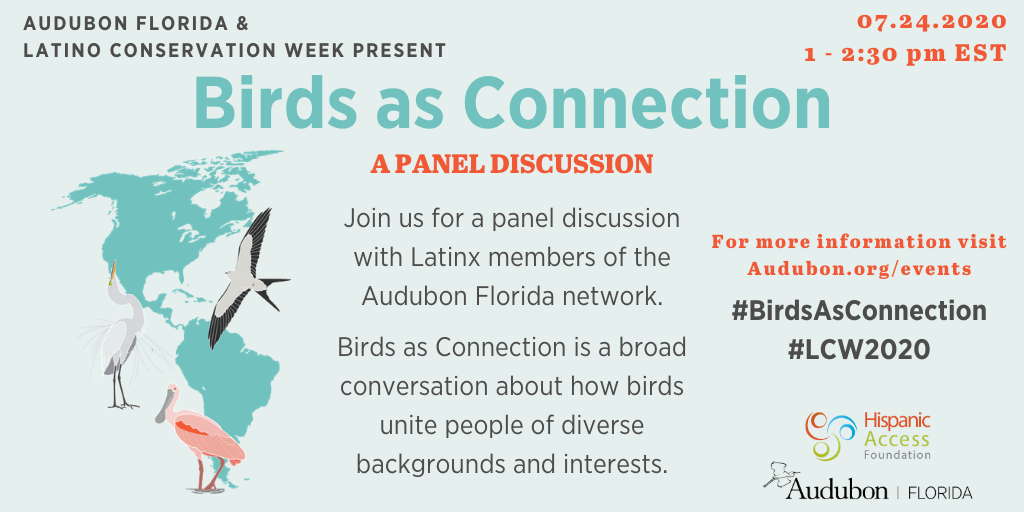
Relevant. Game-changer. Welcome. Possibility. Now. Those were some of the responses provided by panelists when asked to use one word to describe the future of Latinx in conservation during the “Birds As Connection” panel discussion. Hosted by Audubon Florida in connection with Latino Conservation Week on July 24, the virtual event invited a team of panelists from within the Audubon Florida network to participate in a broad conversation about how birds unite people with diverse backgrounds and interests.
The organizers of the panel discussion, Melissa Gonzalez, a board member with Orange Audubon Society and Steffanie Munguía, a National Audubon Society board member, got the conversation started by engaging the panelists in a series of questions. While the panelists’ own backgrounds and career paths are quite different, they all shared a passion for the outdoors and underscored the need to engage more Latinx in conservation.
“If you don’t have a seat at the table, you might be on the menu,” offered panelist Celeste De Palma, “and in this case, if Latinx are not at the Audubon table, they aren’t even on the menu.”
A native of Argentina, De Palma made the decision to change her career path from pre-med to one in conservation after participating in a study-abroad, research-based program in the Peruvian Amazon. She applied for an internship at Tropical Audubon Society and now holds the position of Director of Everglades Policy for Audubon Florida.
“The path to conservation jobs is not always a straight one,” said Rafael Galvez of Florida Keys Hawkwatch and a longtime member of Tropical Audubon Society. He remembers seeing birds as a young teenager, recently immigrated to the U.S., from the back of his dad’s truck hauling tomatoes, lemons, and rocks from one part of Florida to the next. Later in life, while birding near the Everglades, he felt a connection to the migrant workers he could see working in fields nearby.
“It breaks my heart that no one acknowledges their existence and we have a lot to learn in terms of how we include these communities as part of our message,” said Galvez. We need to find ways to include those people who are so important for agriculture, for them to better understand and appreciate this land.
Many Latinxs prioritize conservation when in their home countries, but things can shift when they immigrate.
“Latinx issues and concerns are less likely to be taken into consideration unless more Latinxs are in a position to make decisions,” said Lida Rodriguez-Taseff, a trial lawyer and member of the Audubon Florida Board of Directors.
Rodriguez-Taseff, born in Bogota, had an opportunity to see an Andean Condor as a child. She was amazed by the bird’s size, and by its huge talons. To this day, whenever she sees a vulture soaring in the sky, she is reminded of her childhood in Colombia.
“It is incumbent on us to make sure we bring our connections into the fold,” said Rodriguez-Taseff.
For Paola Ferreira, executive director for Tropical Audubon Society, local non-governmental organizations need to include the Latinx community in their mission because they make up so much of the population. Now, due to the pandemic, many municipalities are having their public meetings on Zoom, making it even easier to participate and share thoughts through public comments.
“Figure out what you’re good at and find a way to use that skill,” said Brian Cammarano, a panelist, a participant in Audubon Florida’s Conservation Leadership Initiative, and the newest seasonal anchor steward for Audubon in Lee County.
Cammarano’s parents cultivated his interest in the outdoors at an early age, always encouraging him to turn off the TV and get outside to play. While participating in a wildlife conservation program on a game reserve in South Africa, Cammarano’s guide showed so much excitement for a Giant Kingfisher they saw along the river that Cammarano forgot all about giraffes and rhinoceroses for the rest of his trip. Later, while getting his degree in biology, he started volunteering with his local Audubon chapter and soon became the “bird nerd” of the family.
Miriam Avello, born in Cuba, has a degree in electrical engineering, and, in her free time, applies her skills surveying birds, turtles, and butterflies. She got hooked on birds and started volunteering at the Cape Florida Banding Station and leads birding trips for Tropical Audubon Society.
Migration is a great tool to connect our continents.
“We keep missing valuable opportunities to connect to our Latinx neighbors through migration,” says Galvez. It is easy to find bird hotspots in cities and connect migrating birds to people’s heritage. Galvez even suggests attracting families by using bird’s regional names to highlight the corridors connecting communities and help remember Florida also needs protection.
Many people think being in conservation requires a degree in science, but conservation also needs accountants, human resource managers, lawyers, and marketing experts. For Latinxs interested in getting involved in conservation, the panel suggests that they do what they love: there is probably an opportunity in Audubon.







